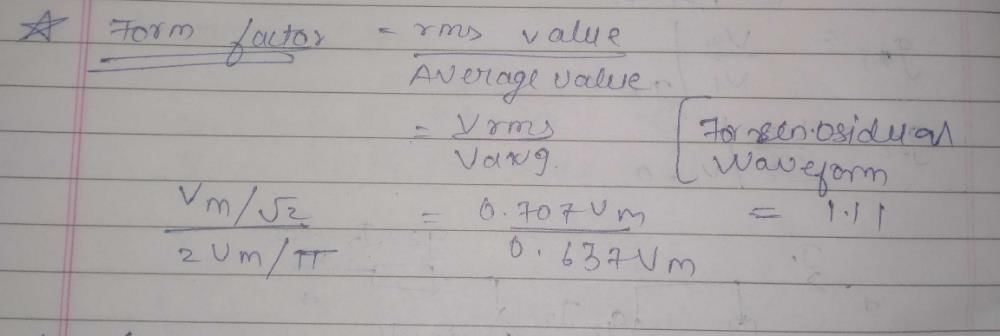Electrical Engineering (EE) Exam > Electrical Engineering (EE) Questions > What is the form factor use in power system ?
Start Learning for Free
What is the form factor use in power system ?
Most Upvoted Answer
What is the form factor use in power system ?

Community Answer
What is the form factor use in power system ?
Form Factor in Power Systems
Form factor in power systems refers to the ratio of the RMS value of a periodic waveform to its average value. It is an important parameter used in power system analysis and design.
Significance of Form Factor
- Form factor is used to characterize the shape of a waveform and is essential in determining the efficiency and performance of power systems.
- It helps in calculating the peak factor, which is the ratio of the peak value of the waveform to its RMS value.
- Form factor is crucial in determining the sizing of components such as transformers, conductors, and circuit breakers in power systems.
Calculation of Form Factor
- For a sinusoidal waveform, the form factor is calculated as the ratio of the RMS value (Vrms) to the average value (Vavg), given by: Form Factor = Vrms / Vavg.
- For a pure sinusoidal waveform, the form factor is √2 or approximately 1.414.
Application in Power System Design
- Form factor is used in designing power distribution systems to ensure the proper sizing of components and efficient power delivery.
- It helps in determining the capacity of equipment such as transformers and switchgear based on the waveform characteristics.
- Form factor is also used in power quality analysis to assess the distortion and efficiency of power systems.
In conclusion, form factor plays a crucial role in power system analysis and design by characterizing the shape of waveforms and determining the efficiency and performance of electrical systems. Understanding and calculating the form factor is essential for ensuring the proper sizing and operation of components in power systems.
Form factor in power systems refers to the ratio of the RMS value of a periodic waveform to its average value. It is an important parameter used in power system analysis and design.
Significance of Form Factor
- Form factor is used to characterize the shape of a waveform and is essential in determining the efficiency and performance of power systems.
- It helps in calculating the peak factor, which is the ratio of the peak value of the waveform to its RMS value.
- Form factor is crucial in determining the sizing of components such as transformers, conductors, and circuit breakers in power systems.
Calculation of Form Factor
- For a sinusoidal waveform, the form factor is calculated as the ratio of the RMS value (Vrms) to the average value (Vavg), given by: Form Factor = Vrms / Vavg.
- For a pure sinusoidal waveform, the form factor is √2 or approximately 1.414.
Application in Power System Design
- Form factor is used in designing power distribution systems to ensure the proper sizing of components and efficient power delivery.
- It helps in determining the capacity of equipment such as transformers and switchgear based on the waveform characteristics.
- Form factor is also used in power quality analysis to assess the distortion and efficiency of power systems.
In conclusion, form factor plays a crucial role in power system analysis and design by characterizing the shape of waveforms and determining the efficiency and performance of electrical systems. Understanding and calculating the form factor is essential for ensuring the proper sizing and operation of components in power systems.

|
Explore Courses for Electrical Engineering (EE) exam
|

|
Similar Electrical Engineering (EE) Doubts
Question Description
What is the form factor use in power system ? for Electrical Engineering (EE) 2025 is part of Electrical Engineering (EE) preparation. The Question and answers have been prepared according to the Electrical Engineering (EE) exam syllabus. Information about What is the form factor use in power system ? covers all topics & solutions for Electrical Engineering (EE) 2025 Exam. Find important definitions, questions, meanings, examples, exercises and tests below for What is the form factor use in power system ?.
What is the form factor use in power system ? for Electrical Engineering (EE) 2025 is part of Electrical Engineering (EE) preparation. The Question and answers have been prepared according to the Electrical Engineering (EE) exam syllabus. Information about What is the form factor use in power system ? covers all topics & solutions for Electrical Engineering (EE) 2025 Exam. Find important definitions, questions, meanings, examples, exercises and tests below for What is the form factor use in power system ?.
Solutions for What is the form factor use in power system ? in English & in Hindi are available as part of our courses for Electrical Engineering (EE).
Download more important topics, notes, lectures and mock test series for Electrical Engineering (EE) Exam by signing up for free.
Here you can find the meaning of What is the form factor use in power system ? defined & explained in the simplest way possible. Besides giving the explanation of
What is the form factor use in power system ?, a detailed solution for What is the form factor use in power system ? has been provided alongside types of What is the form factor use in power system ? theory, EduRev gives you an
ample number of questions to practice What is the form factor use in power system ? tests, examples and also practice Electrical Engineering (EE) tests.

|
Explore Courses for Electrical Engineering (EE) exam
|

|
Signup to solve all Doubts
Signup to see your scores go up within 7 days! Learn & Practice with 1000+ FREE Notes, Videos & Tests.





















